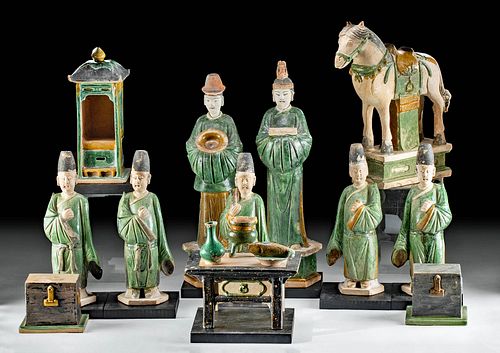Chinese Ming Pottery Royal Marriage Assembly (13 pcs)
Lot 131
About Seller
Artemis Fine Arts
686 S Taylor Ave, Ste 106
Louisville, CO 80027
United States
Selling antiquities, ancient and ethnographic art online since 1993, Artemis Gallery specializes in Classical Antiquities (Egyptian, Greek, Roman, Near Eastern), Asian, Pre-Columbian, African / Tribal / Oceanographic art. Our extensive inventory includes pottery, stone, metal, wood, glass and textil...Read more
Categories
Estimate:
$15,000 - $20,000
Absentee vs Live bid
Two ways to bid:
- Leave a max absentee bid and the platform will bid on your behalf up to your maximum bid during the live auction.
- Bid live during the auction and your bids will be submitted real-time to the auctioneer.
Bid Increments
| Price | Bid Increment |
|---|---|
| $0 | $25 |
| $300 | $50 |
| $1,000 | $100 |
| $2,000 | $250 |
| $5,000 | $500 |
| $10,000 | $1,000 |
| $20,000 | $2,500 |
| $50,000 | $5,000 |
| $100,000 | $10,000 |
| $200,000 | $20,000 |
About Auction
By Artemis Fine Arts
Oct 7, 2021
Set Reminder
2021-10-07 10:00:00
2021-10-07 10:00:00
America/New_York
Bidsquare
Bidsquare : Exceptional Antiquities Ethnographic Fine Art
https://www.bidsquare.com/auctions/artemis-gallery/exceptional-antiquities-ethnographic-fine-art-7537
Museum-worthy examples of Egyptian, Greek, Roman, Etruscan, Near Eastern, Far East / Asian, Pre-Columbian, African / Tribal, Oceanic, Native American, Spanish Colonial, Fossils, Ancient Jewelry, Fine / Visual Arts, so much more! Artemis Fine Arts info@artemisfinearts.com
Museum-worthy examples of Egyptian, Greek, Roman, Etruscan, Near Eastern, Far East / Asian, Pre-Columbian, African / Tribal, Oceanic, Native American, Spanish Colonial, Fossils, Ancient Jewelry, Fine / Visual Arts, so much more! Artemis Fine Arts info@artemisfinearts.com
- Lot Description
East Asia, China, Ming Dynasty, ca. 1368 to 1644 CE. A remarkable royal marriage assembly comprised of thirteen sculpted pieces, all embellished with a lustrous glaze in hues of gamboge, emerald, orange, peach, grey, brown, yellow, and black. Central to the set, the elegant bride and groom both stand atop hexagonal plinths with their hands held together underneath the long flared sleeves of their marriage garments. The bride wears an intricate headdress and a floor-length robe as she carries a rectangular object. Flanked by two pierced ears, her round visage displays slender eyes, arched brows, a flat nose with incised nostrils, and petite lips. A small object inside the bride's head allows her to make a rattling sound. Alternatively, the groom wears a green tunic over a golden-hued robe and an orange hat as he carries a large bowl angled outwards. His naturalistic face features narrowed eyes, a straight brow, a round nose, and a small mouth enveloped by a Fu Manchu moustache and a goatee. Size of largest: 5.25" W x 19.125" H (13.3 cm x 48.6 cm)
The newlyweds are accompanied by a horse, who is heavily adorned with a tasseled saddle blanket, a saddle, and bell-lined reins as it stands on all fours atop a rectangular plinth. The noble steed sports a centrally-parted mane above a long snout with clearly delineated nostrils and huge eyes. The five remaining figures are all male and wear long green robes with yellow or grey sleeve hems, grey belts, and conical, flat-topped headdresses. Four of the figures are sedan chair carriers and stand holding one hand to their chests. The remaining male is an announcer and holds a rattle. Several props are also part of the set, including a large sedan chair, two dowry chests filled with rattling objects, and a dining table set with a footed vessel known as a ding, a vase, and a fish on a platter.
A comparable example of a Ming Dynasty marriage assembly with additional pieces can be found at the Minneapolis Institute of Art under accession number 89.60.1. The description of this beautiful assembly reads, "The Chinese considered weddings to be joyous and auspicious occasions. Marriage was central to the strong Confucian values of family unity and continuity. Within a well-furnished tomb, a ceramic procession such as this would replicate an important and festive occasion for the deceased in their afterlife."
Provenance: private Hawaii, USA collection; ex-Hong Kong Gallery, China, acquired in 1980s
All items legal to buy/sell under U.S. Statute covering cultural patrimony Code 2600, CHAPTER 14, and are guaranteed to be as described or your money back.
A Certificate of Authenticity will accompany all winning bids.
PLEASE NOTE: Due to recent increases of shipments being seized by Australian & German customs (even for items with pre-UNESCO provenance), we will no longer ship most antiquities and ancient Chinese art to Australia & Germany. For categories of items that are acceptable to ship to Australia or Germany, please contact us directly or work with your local customs brokerage firm.
Display stands not described as included/custom in the item description are for photography purposes only and will not be included with the item upon shipping.
#162560All have collection labels on bottoms. Top of bride's headdress restored from new material. Ding missing part of one foot. A few small repairs to bases of dowry chests and sedan chair carriers with restoration over break lines. Legs of table reattached. Repair to ears of one sedan carrier, one side of fish's tail, hat of sedan carrier, and ear of horse with restoration over break lines. Expected surface wear with a few minor nicks/chips and abrasions, all commensurate with age. Otherwise, excellent with impressive remaining pigments.Condition
- Shipping Info
-
All shipping is handled in-house for your convenience. Your invoice from Artemis Gallery will include shipping calculation instructions. If in doubt, please inquire BEFORE bidding for estimated shipping costs for individual items.
-
- Buyer's Premium



 EUR
EUR CAD
CAD AUD
AUD GBP
GBP MXN
MXN HKD
HKD CNY
CNY MYR
MYR SEK
SEK SGD
SGD CHF
CHF THB
THB




















